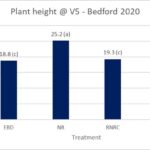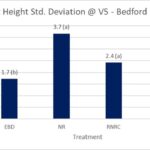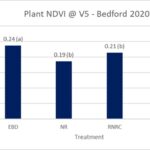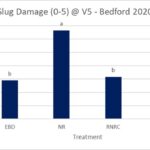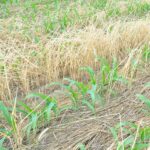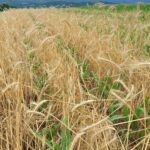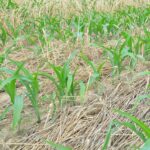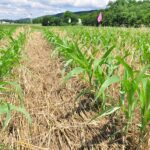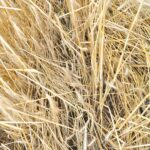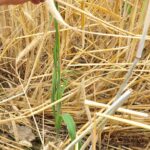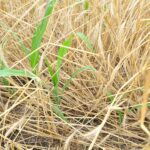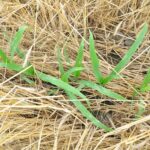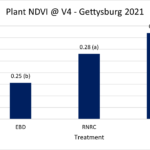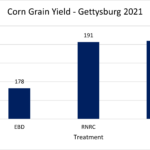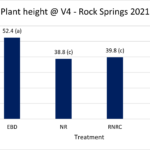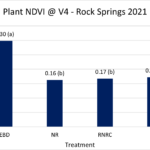Final report for ONE19-339
Project Information
This project explored how planting green into a standing, un-rolled cover crop impacted corn emergence and yield compared to rolling cover crops prior to planting, and row cleaner effects on corn emergence, slug damage and yield when planting green into rolled cover. The trial was replicated at two locations in 2020 and three locations in 2021 in central and southern Pennsylvania. Cereal rye cover crops were seeded at 45-90 bu/A in the fall the year prior to the study. Treatments consisted of early burndown, no roll, roll-row cleaners, and roll-no row cleaners. Corn population, height, slug feeding damage, and normalized difference vegetation index (NDVI) were measured around V4 and V8, and corn was taken to grain, with yield measured with a yield monitor. Not rolling the cover crop reduced corn population by an average of 12% in two of five site years. In the only two site-years where measurable slug damage was observed, not rolling covers increased slug damage ratings by 88-123% over the other treatments. Not rolling the cover crop increased corn height by 10 to 13 cm and increased height standard deviation by 2.9 to 4.0 cm over the other treatments two of five site-years; but, the effect reversed in one of five site-years, where no-roll was 13.6 cm shorter than early burndown. Early burndown or roll-row cleaners had higher NDVI readings or was significantly "more green" than the other treatments across site-years. Yield was not impacted at any site-year in the study, but trended lower in the no-roll treatment.
Based on this trial and the current body of literature, we recommend that farmers roll down cover crops whenever possible; if they cannot, they should not plant corn (though soybeans were not included in our study, there is evidence that they can produce well without rolling). We also recommend that if rolling cover crops, row cleaners should be used if weed control is not the primary objective. Lastly, we found that if planting late into very warm soils, row cleaners have less impact on corn emergence. These findings were presented at 1 webinar, 1 field day, and 4 conferences to a total of 79 farmers and 206 ag service providers.
This proposal seeks to determine if planting corn into standing, un-rolled cover crops negatively affects corn emergence and yield when compared to rolling cover crops prior to planting. Furthermore, it seeks to compare the use of row cleaners to create a bare soil strip around the seed slot versus rolling a cover crop adjacent to the seed slot, and its effects on corn emergence, slug damage and yield. The information gained from this proposal will be utilized to help farmers and educators quantify potential risks of planting into standing cover crops and will provide guidance in equipment setup for those wanting to adopt or refine planting green techniques.
The process of ‘planting green’ or planting a cash crop into a living, standing cover crop (figure 1) has become increasingly popular in the last 5 years. Benefits of the practice include increased biomass production of the cover crop, reduced soil erosion and increased soil cover that provides habitat for beneficial organisms and buffers soil temperature fluctuations. (Reed, et al., 2019).
The implementation of the planting green concept varies widely among farmers. Early attempts included rolling with a cultipacker prior to planting or planting cash crops into standing covers without rolling. The practice evolved with the use of roller-crimpers to flatten cover crops prior to planting. More recently, rollers have been adapted to the planter frame (Dawn ZRX cover crop roller), combining two operations into one pass. This allows rollers to be mated to wider planters and avoids the need to modify tractors, which may be promising for widespread adoption of the practice.
While the roller-crimper has been an effective tool for planting into standing cover crops (figure 2), the enthusiasm and promotion of the practice has led to many farmers attempting to plant green without utilizing a roller-crimper, instead planting corn directly into tall, dense cover crops. Much of this has occurred when planting green has been used as a ‘rescue’ when cover crops have not been terminated in a timely manner. Unfortunately, many farmers reported poor corn emergence when planting green into standing, un-rolled covers (figure 3) resulting in a negative opinion of the practice due to what may be poor execution of the concept.
Research on corn emergence demonstrates that when plants emerge at an uneven rate, they compete with each other, with late emerging plants showing reduced per-plant yields (Boomsma & Vyn, 2007). In addition, un- emerged plants result in lower stand populations which correlates with lower yields. Factors that promote even emergence include consistent soil temperature and moisture in the seed zone and even light exposure to the seed row. As important as these concepts are, they have not been widely documented in printed outreach materials or general discussions of the practice.
For planting green to continue as a popular and growing practice, there should be a greater understanding of how the practice affects corn emergence. This includes demonstrating and quantifying the risks of planting into un- rolled cover crops and the benefits of rolling prior to planting. Therefore, an accurate side-by-side comparison of planting green into standing cover crops and its effects on corn emergence is needed to improve our body of knowledge and promote the successful implementation of the practice. Ultimately, a better understanding of how planting green management practices effect corn emergence will help farmers make better decisions when selecting cover crop species, modifying equipment for planting green and timing cover crop termination prior to planting.
Many studies have documented the effects of late emergence on corn yields. Early research demonstrated that plants emerging 7 and 14 days later than early emergers had yields approximately 2/3 and 1/2 of early emergers, respectively (Ford and Hicks, 1992). Research in Ontario, Canada showed 4% and 8% stand yield reductions when one out of 6 plants was 2 and 4 leaf stages behind the remainder of the stand, respectively (Liu, et al., 2004). A study of emergence in Oklahoma demonstrated that when one out of three plants in a stand emerged late, stand yields were reduced by 3 to 14% when plants emerged two days late and between 10 and 25% when plants emerged 5 days late (Lawless et al., 2012). Observations at 9 locations in Virginia also showed a trend of decreasing per-plant yields for each day that late plants emerged behind the rest of the stand (VA Coop. Ext., 2016).
Multiple guidance documents outline the use of roller-crimpers for planting into standing, living cover crops, with much of the material focusing on cover crop selection and planting rates, timing of rolling and fertility management. However, the effects on corn emergence are rarely noted. Information presented by Steve Groff (formerly presented by Cover Crop Solutions) advises against planting into cover crops greater than 12 inches tall and the PA No-till Alliance cautions against planting in to cover crops greater than 20 inches tall (PA No-Till Alliance, 2017). In both cases data to support these claims is not provided.
At this time there is no known published research as to how planting green into un-rolled and rolled cover crops affects corn emergence. However, Penn State Extension received reports of poor corn emergence in un-rolled cover crops in 2015 and 2016. As a response, educators in the spring of 2017 recorded observations on corn planted into un-rolled cover crops, noting inconsistent emergence, reduced populations and plants having a tall and ‘spindly’ appearance relative to stands planted in rolled or bare fields or where machinery traffic flattened cover crops (Larson, 2018).
A series of observations were recorded in Somerset County, Pennsylvania in corn planted into a cereal rye cover crop. Half of the field was rolled with a cultipacker and half was left un-rolled prior to planting. Plant populations and heights were recorded when plants were at the V5 to V6 leaf stage (table 1). While not structured as an experiment, analysis of the data as a completely randomized design, having lower statistical power than a randomized complete block, showed that corn planted into the un-rolled cover had lower emerged population (p<0.05), greater average plant height (p<0.10) and greater plant height deviation (p<0.01) compared to corn planted into the rolled cover crop. As noted in other reports, many of the corn plants attempting to grow through the un-rolled cover were taller but more spindly than those in the rolled cover.
In addition to a lack of published data of plant emergence in un-rolled covers, there is no documented information regarding the use of row cleaners on corn emergence when planting green. Early designs of planter-mounted roller crimpers utilized a disc-style row cleaner (figure 4), which creates a bare furrow approximately 6 inches wide around the seed slot. However, in attempts to achieve nearly 100% ground cover of the rolled cover crop, some farmers eliminated the row cleaner (figure 5), resulting in a rolled cover immediately adjacent to the seed slot. In both cases there appears to be little data as to how the use or absence of row cleaners affects corn emergence when planting green. Personal observations of full-width rollers (no row cleaners) suggests that closing the seed slot is more difficult and that there may be a greater risk from slug damage due to slugs entering the seed slot to consume germinated but not emerged corn plants. Conversely, those utilizing row cleaners claim they reduce slug damage by creating a “dead” zone between the dying cover crop and emerging corn in which slugs are less likely to cross and feed.
CITATION LIST
Boomsma, C. R., and Vyn., T. J. 2007. Plant-to-Plant Uniformity is Essential for Optimum Yield in No-till Continuous Corn [Online]. Available at https://www.extension.purdue.edu/extmedia/AY/AY-329-W.pdf. Purdue University, East LAyfayette, IN.
Ford, J. H., and Hicks, D. R. 1992. Corn Growth and Yield in Uneven Emerging Stands. Journal of Production
Agriculture. 5:185-188.
Larson. 2018. Planting Green Impacts on Corn Emergence [Online]. Available at https://extension.psu.edu/planting-green-impacts-on-corn-emergence. Pennsylvania State University, University Park, PA.
Lawless, K., Raun, W., Desta, K., and Freeman, K. 2012. Effect of Delayed Emergence on Corn Grain Yields. Journal of Plant Nutrition. 35:480-496.
Liu, W., Tollenaar, M., Stewart, G., and Deen., W. 2004. Impact of Planter Type, Planting Speed, and Tillage on
Stand Uniformity and Yield of Corn. Agronomy Journal. 96:1668-1672.
Pennsylvania No-Till Alliance. 2017. Planting Into Green Living Cover Crops [Online]. Available at https://panotillalliance.files.wordpress.com/2018/02/plantinggreen_laminatedhandout_2017-1.pdf.
Reed, H., Karsten, H., Tooker, J., Curran, W. S., and Duiker, S. W. 2019. Planting Green 101: Penn State Research Summary [Online]. Available at https://extension.psu.edu/planting-green-101-penn-state-research- summary. Pennsylvania State University, University Park, PA.
Virginia Cooperative Extension. 2016. 2016 Virginia On-Farm Corn Test Plots [Online]. Available at https://www.sites.ext.vt.edu/newsletter-archive/corn-test-plots/2016.pdf. Virginia Polytechnic and State University, Blacksburg, VA.
Cooperators
- - Producer
- - Producer
Research
Experimental design and data collection protocol
Treatments at each site included: early burndown, cover crop chemically terminated approximately two weeks before intended corn planting date; no-roll, corn planted green into standing cover crop; rolled-row cleaners, corn planted into a rolled cover crop with row cleaners employed; rolled-no row cleaners, corn planted into a rolled cover crop without row cleaners. Plots were at least one corn planter pass wide and field length at cooperating farms; at Rock Springs, plots were 40 feet long.
At approximately plant stage V4, corn population and height were recorded. Four recordings were taken in each plot in the middle two rows of each planter pass. Corn population was measured over a distance of 20 feet, and plant heights were recorded from the first 20 plants in the same location. Stands were rated for slug damage on a scale of 0-4: 0, no damage; 1, 1-25% defoliation; 2, 26-50% defoliation; 3, 51-75% defoliation; 4, 76-100% defoliation. Average Normalized Difference Vegetation Index (NDVI) was measured over the same distance using a handheld Trimble© GreenSeeker situated at approximately shoulder height. Measurement sites were marked, and plant heights were recorded in the same locations at approximately plant stage V8. Prior to harvest, ear counts were made at the same locations where V4 and V8 heights were recorded to determine if any late emerging plants did not produce ears. Plots were harvested by the farmer and yields were calculated using a yield monitor. Calculated yields were based on the full planter width, i.e., all planted rows will be harvested in one pass.
Corn population, average corn height, corn height standard deviation, slug damage rating, number of missing ears at harvest and corn yield were analyzed using PROC GLM in SAS® 9.4. Treatment was treated as a fixed effect and block as random. At the Gettysburg site in 2021, there was no random effect. Years at the same site were not combined due to differences in weather and management.
Field operations and timing
2019-2020
In 2019, the field sites were seeded with cover crops in preparation for 2020 data collection. Plots at the David Hernley (Bedford County, PA) farm were drilled with cereal rye (VNS) on September 19th at 47 lbs/ac. Plots at the John Johnson farm (York County, PA) were drilled with cereal rye (VNS) on November 30th at 90 lbs/ac. The higher rate at the York site was utilized due to the much later planting date of the cover crop.
In 2020, the York County site hosted by John Johnson had to be dropped as Mr. Johnson suffered a heart attack over the winter and Dr. Reed and I felt that it was not appropriate to require Mr. Johnson to participate in the study during his recovery. In place of Mr. Johnson's site, research was conducted at the Penn State's Russel E. Larson Agricultural Research Center (Rock Springs) near State College, PA.
At the David Hernley Farm in Bedford, PA, research was conducted as planned. The early termination plots were sprayed on 4/15 and planting occurred on 5/15. Remaining standing cover crops were terminated on 5/21, however some rolled plots stood up due to wind. The majority of planting measurements were taken on 6/17 at growth stage V/5, including population, plant height, and Greenseeker and lightbar readings. Slugs were present at Bedford and slug damage ratings were taken. The plots were sidedressed in late June and no other field activities occurred until harvest. Fall activities included recording ear counts on 10/20 and harvesting plots on 11/20.
The data taken at the the Penn State Rock Springs Ag Research Station was piggybacked off of study carried out by Dr. John Wallace on herbicide programs in planting green scenarios. The Aroostook rye cover crop was seeded on 10/1/19 at 90 lbs/ac. Early termination plots were sprayed at late boot stage on 4/28, and the remaining cover crops were sprayed on 5/19. Planting occurred on 5/19 and a sidedress nitrogen application was performed on 6/29. Measurements of plant height and population and GreenSeeker and lightbar readings were taken on 6/19 at stage V5. There was no observable slug damage at the Rock Springs site. Exclusive to the Rock Springs site, plant height measurements were also taken at tassel (VT) on 6/27. Ear counts were recorded on 10/7 and plots were harvested on 10/11.
2020-2021
The field site for the 2021 Bedford County trial was seeded on 9/17 at 45 lbs/ac, however due to extremely dry conditions throughout the summer and fall emergence was very uneven. Thin spots in the stand were seeded on 11/21 with wheat at 75 lbs/ac. The field site for the 2021 Adams County trial was seeded with cereal rye at 95 lbs/ac on 11/10.
At the David Hernley Farm in Bedford, PA, 2021 research methods closely followed those from 2020. However, 2021 plots were smaller as poor cover crop establishment forced the exclusion of some of the study area. The early termination plots were sprayed on 4/22 and planting occurred on 5/21. Corn population and emergence measurements were taken on 6/14-15, growth stage V4 including population, plant height, and Greenseeker and lightbar readings. Slugs were again present and slug damage ratings were recorded. A second Greenseeker measurement was taken on 6/24 at growth stage V6. Ear counts were recorded on 11/2 and plots were harvested on 12/1.
Research was also performed at a second cooperator location in Adams County with Matt Kehr. However, the available equipment was such that an un-rolled treatment could not be implemented, with the site having early burndown, rolled-row cleaners and rolled-no row cleaners treatments. Cover crop early termination was performed on 6/5 and planting occurred on 6/17. Despite late-May being the planting date goal, rainy weather and heavy clay soils that took a long time to dry out delayed operations. Measurements of plant height and population and Greenseeker readings were taken on 7/7 at stage V4. Second Greenseeker readings were taken on 7/15. There was no observable slug damage at the site, likely due to the very late planting and warm, dry weather in mid-June at planting time. Late season ear counts were performed on 10/22 with harvest occurring in November 2021.
Similar to 2020, the 2021 Rock Springs research was performed on a site also hosting an herbicide study performed by Dr. John Wallace. Early termination plots were sprayed at late boot stage on 4/30 and planting occurred on 5/16. Measurements of plant height and population and Greenseeker readings were taken on 6/18 at stage V5. There was no observable slug damage at the Rock Springs site. Second Greenseeker measurements were taken at V7 on 6/29. Ear counts were recorded on 10/21 and harvest occurred in November 2021.
Changes from original methods
A slight change in the experiment design occurred prior to 2020. The initial design called for a split plot design with two main plots (rolling, no roll) and 2 split plots (row cleaners up, row cleaners down) for a total of four treatments: roll-row cleaners, roll-no row cleaners, no roll-row cleaners, no roll-no row cleaners. This initial design did not include an early burndown control plot and due to the setup of the planter it was infeasible to operate with the roller up but the row cleaners down. Therefore the design was changed to a randomized complete block with the following treatments: early burndown, roll-no row cleaners, roll-row cleaners, no roll. Ultimately, we thought that this was a better option as the study would include a burndown that represents typical PA cover crop termination practices. Additionally, we believed that there would be little observable difference between the row cleaner subplots in the no roll treatment and that four separate treatments would provide more meaningful data for the experiment.
In 2021, due to cooperator error at the Gettysburg site, the site was arranged in a completely randomized design instead of randomized complete blocks.
2020
Planting of the Bedford PA plots proved to be challenging in obtaining the desired condition for each treatment due to a few issues. First, the row cleaner in the Dawn ZRX setup is such that it moves up and down with the cover crop rollers. The row cleaner depth of cut can be adjusted relative to the roller by turning a threaded rod, however at the highest position the row cleaner still dug into the ground when planting on slopes or bumps as the toolbar of the planter pitched down relative to the tractor. This resulted in places in the rolled-no row cleaner treatment where there was in fact row cleaning. Plant population and height measurements were taken in areas where the desired rolled but tight to the seed slot condition was present, however yield measurements will capture all conditions across the treatment. Additionally, high winds after planting combined with a later than desired post-planting cover crop termination blew some of the rolled cover back up, creating a low standing cover condition in some places and covering the row in the rolled-row cleaner treatment. Like with the planting issues noted above, plant height and population measurements were taken when the desired treatment condition was present, with those issues possibly affecting plot yields.
Learning from the Bedford issues, a different strategy was implemented at Rock Springs. In place of raising and lowering the row cleaners between treatments to obtain a rolled-row cleaners and rolled-no row cleaners treatment, an I&J 10 ft. cover crop roller was front mounted to the planting tractor to eliminate issues with incidental row cleaning on the rolled-no row cleaners treatment resulting in the following planter treatments: early burndown (ZRX rollers down to engage row cleaners), no roll (ZRX rollers and row cleaners raised), roll-row cleaners (ZRX rollers down and row cleaners down), roll-no row cleaners (I&J row roller down, ZRX rollers up). This better resulted in the four desired, post planting conditions: early burndown with row cleaning, tall standing cover, rolled cover crop with cover tight to seed slot, and rolled cover crop with a cleaned "dead zone" adjacent to the seed slot.
Another issue encountered in implementing the experiment methodology is excessive cover rolling in the no roll treatments. When a 4 row planter is utilized, wheel traffic from the tractor and planter rolls a substantial amount of the cover in the no roll treatments, leaving 1-2 rows that have standing cover on each side of the seed slot. Plant population and height data was effectively recorded from those areas, but the rolling of a portion of the crop may mask yield differences that would otherwise be expressed if a wider planter was used and a larger percent of the no roll treatment was left undisturbed.
Results & Discussion
At the Bedford site corn population was 10% lower in the no-roll treatment (29,463 plants/A) than the other treatments (average 32,591 plants/Acre, α=.0948). Plants were taller at V5 for those in the un-rolled cover, being on average 3.3 and 6.4 inches taller than those in the rolled row-cleaner and early burndown treatments, respectively, as hypothesized (α<.0001). Plant height standard deviation was greater in the un-rolled cover as well, approximately 2 inches greater than the deviation found in the early burndown treatment (α=.0003) Physical differences between the plants were present as well, with those in the un-rolled cover having a much longer, but narrower leaf surface with less plant rigidity, resulting in a more "spindly" appearance. It appears that the plants are dedicating all carbohydrate reserves to putting on plant height to escape the shading of the cover, at the possible expense of stalk and root development.
In addition to height differences, plants in the un-rolled area experienced greater slug damage on average, with visual ratings of damage double that of all other treatments a the Bedford location in 2020. Plant NDVI readings, as recorded with the Greenseeker, were significantly lower in the no roll treatment, when compared to the early burndown and rolled with row cleaners treatment (α=.007). The number of harvestable ears per acre in the un-rolled treatment was significantly lower than that of the early burndown treatment as well, with the early burndown having over 3,000 more ears per acre at harvest (α=.05). Interestingly, the ratio of harvestable ears per acre to the V5 plant population was between 0.97 to 0.99 for the early burndown, rolled-row cleaners and rolled-no row cleaners, while for the un-rolled treatment the ratio was 0.91. This suggests that a higher rate of plant mortality or reduced ear development occurred in the un-rolled cover. There was no difference in yield between treatments at the Bedford (average 176 bu/A), but the early burndown treatment did trend higher and the no-roll treatment lower than the rolled planted green treatments. Selected data from the Bedford site is shown below.
Contrary to the Bedford site, at Rock Springs, treatment had no effect on corn population (average 32,755 plants/Acre), plant height deviation (average 5.3cm), and harvestable ears (average 30,854 ears/Acre). The ratio of harvestable ears per acre to the V5 corn population averaged 0.92 for early burn down and no-roll, and 0.97 for the rolled treatments, in contrast to the Bedford site. There was also no measurable slug damage. Corn in the no-roll treatment was 10 cm taller than the average 57 cm height of the other treatments (α=.0009). NDVI readings, or "greenness," was significantly higher in the early burndown treatment than any of the planted green treatments (α=.0015). Also similar to Bedford, there was no treatment affect on yield. A possible explanation for less pronounced differences at Rock Springs is that the Rock Springs location had lower levels of biomass in planted green treatments compared to the Bedford site.
2021
Conditions in 2021 at the Bedford site were similar to those in 2021 in terms of cover crop biomass and planting timing. However, a different planter had to be used for 2021. Unfortunately the planter was lighter compared to the one used in 2020, making it difficult to transfer enough weight to the rollers and row units in some spots. However, emergence looked good despite what may have been slightly shallower planting depth. The conditions at Rock Springs were much more challenging, with an extremely heavy, lodged cover crop present at planting.
For the Rock Springs location a newly upgraded planter, equipped with many Precision Ag components, was used for 2021. Unfortunately, the high biomass cover lifted the row units such that adequate planting depth could not be achieved, and the planter sensing the shallow depth shut off the row units, drastically altering as-planted populations. However, this issue can be easily identified in the field as all four rows shut off at the same time, so measurements were not taken in those areas.
The conditions at the Adams County site were typical for the area and consistent across the study. Despite late-planting by a regional standard, locally the mid-June corn planting was just slightly behind. The field was mostly Croton silt loam, which is "poorly drained" and "occasionally ponded" according to Web Soil Survey. Untimely rainfall prevented field operations, and the field took a very long time to dry satisfactorily for wheel traffic; however, it should be noted that a true "early burndown" by the local standard should have occurred in the early May timeframe. By early burndown, the rye was already at anthesis, so there was essentially no difference in biomass between early burndown and the planting green treatments. At that late stage of maturity, even with an additional 12 days of growth, the rye in the planting green treatments was well beyond the vegetative growth stage and starting to set seed.
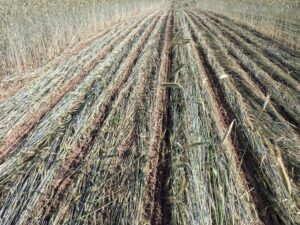
Results
Selected data from Gettysburg and Rock Springs sites are shown above.
Bedford revealed differences in V4 population in 2021 as in 2020, with the no roll and rolled-no row cleaner having 13% lower populations than the early burndown and rolled-row cleaner treatments (α=.0077). There were no differences in plant height in 2021 (average 47 cm), although taking measurements one growth stage earlier may have affected those results. Similar to 2020, plant height standard deviation was impacted by treatment, with no-roll having a standard deviation of 8.1 cm compared to the 5.2 cm average deviation of the other treatments (α=.0004). Additionally, plant NDVI readings, were significantly lower in the no roll treatment, when compared to the early burndown and rolled-row cleaners treatment (α<.0001). Slug damage patterns were also similar in 2021, with the un-rolled treatment showing significantly higher slug damage, on average (α=.0016).
At Rock Springs in 2021, NDVI results reflected 2020, with early burndown NDVI (0.30) nearly twice that of all the other treatments (average 0.17, α=.0015). For plant height, early burndown was surprisingly taller (52 cm) than rolled-row cleaners (45 cm), which was taller than the rolled-no row cleaners and no roll treatments (average 39 cm, α=.0056). As in 2020, there was no difference between treatment impacts on plant population (average 27,418 plants/Acre) or plant height standard deviation (6.4 cm), and no measurable slug damage. However, early burndown trended higher in population than the other treatments (30,219 vs average 26,485 plants/Acre). Unfortunately, with the biomass interference with the precision planting mechanism explained previously, comparable yields between treatments could not be extracted.
At Gettysburg, corn population (average 35,020 plants/Acre), plant height (average 44 cm), height standard deviation (average 3.6), harvestable ears (average 33,389 ears/Acre), and yield (average 187 bu/A) were not significantly influenced by treatment. However, NDVI was impacted; both the rolled planted green treatments were more green (average .29) than the early burndown (average .25, α=.0077). Though not significant, early burndown trended shorter (42 vs 44 cm) than the other treatments and lower in yield (178 vs 191 bu/A). The ratio of harvestable ears per acre to the V4 plant population was 0.98 early burndown compared to 0.93 and 0.95 for roll-no row cleaners and roll-row cleaners, respectively. An explanation for the planted green treatments trending higher in yield than the early burndown, is that a moderately severe drought impacted the area for most of July and August. With slightly more biomass and more likely higher C:N, slower to decompose late killed rye in the planting green treatments provided residue cover for more of the summer, helping to trap water in the soil and getting corn through the drought, resulting in numerically higher yields in those treatments. The lack of significant impacts at the site was unsurprising due to the later than desired early burndown, and late corn planting minimizing physical differences between the treatments. Soil was sufficiently warm that, corn emerged quickly and any interference from rye residue that the row cleaners may have provided was not needed.
The goal of this project was to determine the effect of rolling versus not rolling cover crops, and employing row cleaners versus not on corn emergence, slug damage, and yield.
In two of five site-years, corn population was highest in either early burndown or rolled-row cleaners; in two of five site-years, no-roll corn was significantly taller and had greater height standard deviation than other treatments; in three of five site-years, early burndown corn was the greenest, with the second greenest being rolled-row cleaners; in two of five site-years, no-roll had significantly more slug feeding damage than other treatments.
This provides evidence that corn population can be significantly reduced and emergence slowed, and slug damage can be increased by not rolling compared to rolling when planting green. We also found that, though measurements were often not different between rolled treatments, in some instances row cleaners resulted in higher populations or shorter, greener plants; though, there was no impact on corn yield in any site-year. Finally, we learned that, despite the benefits of planting green, regardless of rolling or not, there are instances when the practice has drawbacks compared to early burndown, including more slug feeding and reduced corn yield.
Being sure to roll and use row cleaners in most situations instead of no-roll or roll-no row cleaners, our cooperators could potentially save up to $60 per acre in a bad slug year by rolling their cover crops when planting green instead of not rolling, by reducing slug damage and therefor the need for rescue slug treatments, which are notoriously expensive. Though both cooperators already have rolling equipment, these findings may not improve their production practices; however, in sharing these data with 79 farmers and 206 ag service providers, planter set-up for planting green has the potential to be optimized on many thousands of acres.
Education & Outreach Activities and Participation Summary
Participation Summary:
In the summer of 2020, Penn State Extension held a virtual agronomy webinar series, with participants roughly split between farmers and crop consultants. On 8/14 Zachary Larson spoke at a session focusing on planting green. While no data was discussed, he reviewed the concepts of which this work as based and shared progress pictures from the Rock Springs and Bedford sites, with initial impressions of field conditions.
Initial results were presented by Zachary Larson in October 2021 at the Keystone Crops and Soils Conference in Grantville PA to an audience of crop consultants. This included a review of all 2020 results, reviewed on a per-location basis and 2021 data recorded up to September.
Plans were in place to present the data at the Western PA Soil Health Conference in Latrobe, PA in January 2022, however, the event was cancelled. However, Heidi Reed will present results at the same conference in January 2023.
Results were presented by Heidi Reed at the Lebanon Crops Day in Lebanon, PA in February, 2022 to 8 farmers; at the Farming For Success Field Day in Manheim, PA in June 2022 to 20 farmers and 40 ag service providers; at the Agronomy Crop and Soil Science Societies of America Annual Meeting in Baltimore, MD in November 2022 to 27 Certified Crop Advisers, Extension specialists and educators, and researchers; and twice at the Mid-Atlantic Crop Management school in Ocean City, MD in November 2022 to a total of 88 Certified Crop Advisers.
Results were used to bolster discussion during a planting green demonstration at Ag Progress Days in August 2022 in Pennsylvania Furnace, PA in collaboration with the Pennsylvania No-Till Alliance. The Live demonstration was held 3 days in a row, and a total of approximately 20 farmers and 20 ag service providers participated. We used summer seeded sorghum sudangrass as a proxy for high biomass winter grains for the demonstration.
A Penn State Field Crop News article summarizing results is in progress, and will be shared in winter 2023 in preparation for the growing season.
Learning Outcomes
At the Keystone Crops and Soils Conference approximately 8 crop advisers were involved in a follow-up discussion of planting green, whereby the results were discussed along with personal experiences. The presented data confirmed to the group that rolling should occur when planting corn to prevent issues with low plant populations, variable plant populations and yield loss.
During the summer of 2021, two farmers interested in planting green from Blair County, PA were given a tour of the Bedford site. There we observed the differences in treatments and discussed Mr. Hernley's experiences with planting green. The two Blair farmers had intentions to plant green without rolling the cover, but after seeing the difference first-hand, decided that they should purchase cover crop rollers before attempting the practice.
Project Outcomes
Since attending programs discussing the project, 5 farmers started planting green or changed planting green practices. Acreage was solicited but not shared.
Evaluation data from the most recent programs has not been returned yet; the report will be updated when those impact data are available.
We faced several challenges with our programming severely limited for all of 2020 and much of 2021 due to COVID-19. Despite the difficulty in reaching farmers, we reached over 200 ag service providers, who each may service thousands or tens of thousands of acres, providing insight for their farmer clients.
We learned that there are limitations with planter set up variations, depending on the planter and attachments. To overcome this it would be best to use a large drum roller to roll all the rolled treatments first, then plant green with a no-till planter (without rollers) where there is more flexibility on row cleaner employment, making sure to plant the same direction of the roller pass. This would also allow many more farmers to participate, including those who do not currently have planters set up to plant green.
We did answer the question we set out to, but much more work could be done with the same protocol (as amended above), with additional soil types and climates, different species of cover crops, different corn hybrids, different styles of row cleaners and coulters, etc. The opportunities for exploration in planting green are endless, as there is so much we still don't know. Genotype x management x environment work is lacking and would be beneficial.
We will still recommend planting green in certain situations, depending on grower goals and equipment. As of this work, we would not recommend planting corn green if a grower does not have access to a roller-crimper.
Growers and ag service providers in the mid-Atlantic would benefit most from these results, as it is most applicable to this region.
Information Products
- Farming For Success Field Day Handout (Conference/Presentation Material)
